Effects of erosion on the eroded site: loss of productivity
The economic cost of erosion on the eroded site itself can be expressed in a variety of terms.
LOSSES IN PRODUCTIVE LAND AND OTHER OBSTACLE TO DEVELOPMENT
Taking the example of the Salci pineapple plantation at Ono in southern Côte d'Ivoire, land clearance, followed by mechanized farming of a 1000-ha industrial plantation very quickly brought erosion problems, which were countered by installing access tracks along contour lines, establishing grass-covered ridges and alternating rows of pineapples of different ages and ground-covering capacities: it takes six months for a pineapple to cover more than 90% of the soil and protect it against erosion. However, in about 1973, the importation of new mechanized cropping techniques from Hawaii, based on a tanker with a 17-m sprayer arm for fertilizer, weed-killer and nematicide meant a further redesign of the plantation, eliminating the banks and contour tracks to allow for 34-m wide planted rows more or less following the contour lines. Gullying erosion appeared at once, preventing the heavy machinery from reaching whole sectors, which therefore had to be worked once more by hand (which was not very cost-effective). The proportion of productive land lost to erosion (gullying, plants uprooted, the burying of plants under a layer of sterile sand, etc.) amounted to barely 2%, which is a more than acceptable figure. However, the affected area that had to be abandoned for mechanization was much greater (70 ha for one large gully alone) and production delays increased every year. Once channels have formed, runoff water generally follows the same route, so that soil loss increases over time. It is interesting to note that 1000 ha of small plots cleared and manually farmed by small African planters have never had any erosion problem. The use of heavy vehicles reduces soil infiltration capacity and increases runoff, which collects on tracks before creating gullies on the plots. In tropical areas erosion takes effect very fast - about two to four years - whereas it takes 30 years for similar effects of excessive mechanization to be observed in Europe.
Another example. In England, Evans (1981) studied erosion on a 10 × 10 km area north of London. Here again, the actual area effected by erosion was small (2.9%) but concentrated in certain points: the steep slopes bordering the loess uplands and farmed by the poorest farmers, who could not afford to rest the land or put it under permanent pasture, since they have to ensure food self-sufficiency or at least a corresponding cash income. The potential risks of erosion on these steep slopes and of damage in the case of heavy rainstorms are much greater than on the plateaux, which belong mostly to rich landowners. There may therefore be a connection between erosion risks, the social and economic level of small farmers, fragile land, and the interest of such farmers in erosion control.
LOSSES IN YIELD AND PROFIT MARGINS
Although production losses (2 to 5%) may be slight and easily compensated for in regional terms through the use of new inputs (fertilizers, drainage, mechanization of tillage), the situation is very different for individual small farmers. As much as 10% of topsoil can be lost on this steeply sloping land, with a 30% fall in production and a 50% fall in net income once inputs have been paid for, so that the profit margin essential for the farmer's family shrinks seriously. Erosion therefore has a greater effect on small farmers, who will be marginalized for lack of credit facilities, initiative or know-how. And they can do nothing about it without a radical change in production methods (high-return production). So there is spiralling impoverishment for the poor and a search for new solutions by those who have the means.
VARYING EFFECTS OF EROSION ON SOIL PRODUCTIVITY
In the United States the cost of the Soil Conservation Service and its slight impact on soil loss led people to question the effects of erosion on soil productivity (the basis of Bennett's SWC system). It was observed that productivity had hardly fallen at all on deep loess soils, which are homogenous to a depth of several metres; indeed, the ill effects of erosion (-1% in yields) were easily made up for by providing new inputs (Dregne 1988) (cf. Figure 6). On the other hand, thin rendzines (forest soils where fertility is concentrated in the topsoil) and many tropical soils very quickly lose their productive capacity.
SELECTIVE EROSION OF FINE PARTICLES, NUTRIENTS AND ORGANIC MATTER
If the quality of eroded soil and the runoff water collected downstream of the eroded plots is compared with the soil left in place to a depth of 10 cm, in terms of plant cover and extent of losses through erosion (Table 3), the following results are seen (Roose 1977a):
• nutrient losses grow in parallel with the volume of runoff and eroded matter; but the nutrient content of soil falls more slowly than the rise in the volume of displaced soil and water;
• much higher proportions of nutrients are found in the water and eroded soil than in the soil in place (horizon: 10 cm); this is clear for carbon, nitrogen, phosphorus, clay and loam (up to 50 m) but still more striking for exchangeable bases (14 to 18 times more on cropped land); sheet erosion is thus selective in terms of the nutrients and colloids that are the essence of soil fertility;
• the lower the eroded volume the greater the selectivity of sheet erosion, i.e. from bare to cropped and from cropped to forest land.
FIGURE 6 Cumulative effect of erosion on soil productivity at different levels of fertility (cf. Dregne 1988)
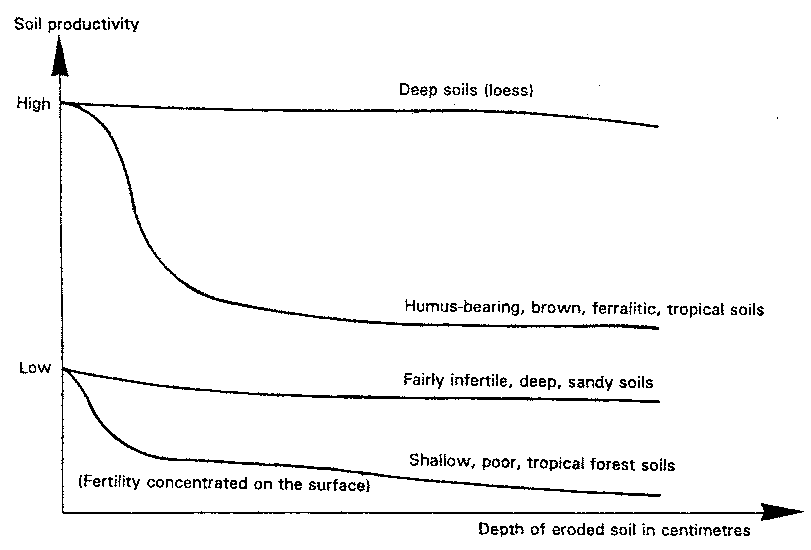
This is easily explained in two ways (Figure 7). On the one hand, the removal capacity of sheet runoff is slight since it is slowed down by the roughness of the soil surface, stalks, exposed roots and litter. Sheet runoff can remove only the light matter: the organic matter, clays and loams to which most nutrients are bound. Forest soils, on the other hand - and to a lesser extent savannah soils - accumulate organic matter and nutrients on the surface. When the rain beats down on these soils the first few millimetres - the richest - are the first to be eroded. The more erosion advances, the more it comes from rills and gullies, and the more the generally poorer subsurface is involved. Scoured land is thus less selectively enriched than in the case of surface sheet erosion.
THE COST OF NUTRIENT LOSS
Another aspect of economic loss from erosion is the amount and cost of fertilizer needed to replace the nutrients lost through erosion. This has been calculated by Roose (1973 and 1977a) for southern Côte d'Ivoire. Under secondary rainforest, chemical losses from erosion are slight: 26 kg/ha/yr of carbon + 3.5 kg of nitrogen + 0.5 kg of phosphorus, and a few kg/ha/yr of bases. These losses are easily made up through biological upwelling (OM deposits in litter) and the nutrients in rainwater.
TABLE 3
Selective losses from
sheet erosion on a 7% slope at (Adiopodoumé Côte d'Ivoire) as a
function of plant cover (cf. Roose, 1977a)
Total erosion
(kg/ha/yr) |
Selectivity factor as
a function of soil in place (10 cm) |
|||||
Forest |
Crop |
Bare soil |
Forest |
Crop |
Bare soil |
|
Total carbon |
26.4 |
855.6 |
2725 |
12.8 |
2.1 |
1.5 |
Total nitrogen |
3.5 |
98.3 |
259 |
22.5 |
3.1 |
1.9 |
Total phosphorus |
0.5 |
28.5 |
111 |
6.6 |
1.4 |
1.3 |
Exchangeable CaO |
3.0 |
49.9 |
113 |
492 |
18.5 |
9.7 |
Exchangeable MgO |
2.2 |
29.0 |
45 |
327 |
14.1 |
5.1 |
Exchangeable K2O |
1.2 |
17.7 |
35 |
550 |
2.4 |
1.1 |
Exchangeable Na2O |
0.6 |
9.5 |
15 |
849 |
15.4 |
5.6 |
Total CaO |
3.7 |
57.1 |
139 |
216 |
8.8 |
5.0 |
Total MgO |
2.3 |
39.0 |
78 |
60 |
5.8 |
2.7 |
Total K2O |
1.3 |
35.1 |
87 |
18 |
1.7 |
1.0 |
Total Na2O |
0.6 |
12.6 |
27 |
49 |
3.2 |
1.6 |
Clay 0-2 microns |
64.5 |
5142 |
18275 |
5.9 |
1.2 |
1.1 |
1.5 |
1.2 |
|||||
Loam 2-50 microns |
33.8 |
2179 |
7115 |
7.7 |
2.5 |
1.9 |
Fine sand 50-200 microns |
1.7 |
5174 |
-23135 |
0.1 |
0.6 |
0.6 |
Coarse sand 200-2000 |
0 |
19305 |
89375 |
0 |
0.9 |
0.9 |
1.1 |
1.2 |
|||||
Total erosion t/ha |
0.11 |
32 |
138 |
|||
Runoff m³/ha |
210 |
5250 |
6300 |
|||
• The first observation is that the total eroded products are less than the erosion indicated at the bottom of the table, inasmuch as the amounts of Fe2O3, Al2O3 and SiO2 (clays) have not been counted - nor, more especially, that of the residue insoluble in triacide (quartz sands).
• The increase in chemical losses is almost parallel with that of soil losses, and is thus in inverse proportion to plant cover. Nutrient concentrations in the eroded substances decrease somewhat as erosion increases, but this decrease is not proportionate to the increase in water and soil losses.
• Since erosion has short- and medium-term repercussions, a distinction must be made between directly absorbable (exchangeable) nutrient elements and those included in mineral reserves.
• Carbon and phosphorus depletion takes place mainly in solid form (bedload and suspension), whereas nitrogen, total bases and especially exchangeable bases migrate exclusive in solution.
On the other hand, under extensive cropping with fairly poor ground cover, nutrient loss from erosion in kg/ha/yr amounts to 98 kg of nitrogen, 57 kg of calcium, 39 kg of magnesium, and 29 kg of phosphorus and potassium. To compensate these losses by fertilizer applications would take 7 tonnes of fresh manure, 470 kg/ha of ammonia sulphate, 160 kg of superphosphate, 200 kg of dolomite, and 60 kg/ha/yr of potassium chloride. Unsurprisingly, then, the soils of southern Côte d'Ivoire are exhausted after two years of traditional cropping, especially when removal by harvesting and losses through drainage (800 mm per year) are also added into the equation.
FIGURE 7 Selectivity, the danger of sheet erosion
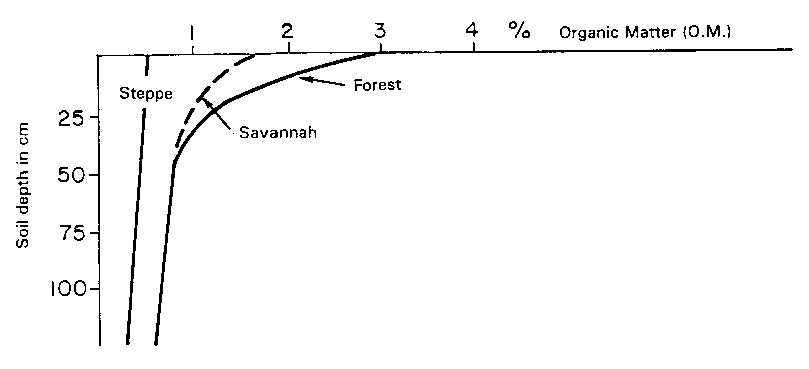
SHEET EROSION IS DANGEROUS, inasmuch as:
• it is hard to recognize:
even if erosion = 12 t/ha/yr = 1 mm of soil, it is less than natural soil respiration;
• it greatly reduces the infiltration capacity of soils (slaking crust);
• it selectively removes the fine, light particles (organic matter, Clay + Fine loam).
TWO REASONS FOR THE SELECTIVITY OF SHEET EROSION:
1. The energy of sheet runoff is too weak to move coarse particles: the roughness of the soil surface reduces the speed and competence of sheet runoff. Only organic matter, clay, silt and their associated nutrients leave the plot; sand moves over the soil surface and forms colluvial soil at the bottom of the slope. If erosion speeds up, rills appear in which erosion is no longer selective.
2. The soil surface is generally richer in organic matter, especially under forest.
THREE EFFECTS
1. Accelerated imbalance in nutrients (see Table 4)
2. Accelerated imbalance in organic matter, leading to degradation in structure, macroporosity and infiltration capacity.
3. Soil skeletonization through the relative accumulation of coarse particles on the soil surface.
CONCLUSION
Sheet erosion speeds up physical, biological and chemical degradation in the surface horizons of cultivated land.
Stocking (1986) later took Hudson's data from analyses of soil and water collected on different plots in the 1960s, together with a map of present-day land use in Zimbabwe, and calculated that each year the country lost 10 million tonnes of nitrogen and 5 million tonnes of phosphorus as a result of erosion.
Fortunately, the nutrients lost to these plots are not definitively lost to the country, but can be recovered on plots downstream, nourish fish, or perhaps end up on rich alluvial or colluvial land, though they may equally well provoke eutrophication. Nevertheless, before launching a mineral fertilization project, nutrient losses from erosion must first be halted, for they cause a serious chemical imbalance in cultivated land (Roose 1980a; Roose, Fauck and Pedro 1981).
PRODUCTION LOSSES CAUSED BY RUNOFF
In hot countries with temporary arid seasons, biomass production depends on soil fertility, but still more on water availability when the crop needs it.
Now, if the water balance is calculated even roughly (Roose 1980a, or Somé 1989), it can be seen that in subequatorial zones, development of 25% runoff (a frequent rate on land under cereals, cassava and other foodcrops) leads to a reduction in the volume of water draining below the roots. This means that there is a certain compensation between nutrient loss through runoff and through drainage, although very few effects of runoff are seen on real evapotranspiration, biomass production and crop yields.
Against this, in semi-arid zones (mean annual rainfall less than 700 mm), the same percentage of runoff actually observed under foodcrops and cotton not only limits the possibility of drainage (and hence of groundwater recharge), but also reduces real evapotranspiration and hence the potential for biomass production (Figures 8 and 9).
In the day-to-day reality of arid zones, the depressive effect of runoff on production is even more acute if water storage in the soil is lowered by runoff at the start of the cropping cycle (delayed seedling planting), or low during flowering (few ears fertilized) or at the end of the cycle (grains imperfectly filled) due to poor runoff and groundwater management (Nicou, Ouattara and Somé 1987). In Sudano-Sahelian zones the impact of runoff from the first storms at the onset of the rainy season deserves emphasis. These storms clear the surface of organic residues and animal wastes that have collected throughout the dry season. Such losses of organic matter lead to a considerable drop in the productivity of land on the broad pediments of Sudano-Sahelian zones.
Another generalized effect of runoff, whatever the climate, is to reduce the concentration period of rainwater, increase peak discharge (and hence sediment load and the scale of structural works), and cause a reduction in the base discharge of rivers, particularly in the dry season when water is needed for irrigation purposes.
Hydrologists, who often look for catchment areas with heavy runoff after each rainfall to feed lakes, reservoirs or towns, have a very different viewpoint from agronomists, who look for better infiltration and better actual evapotranspiration for better plant production. Hydrologists and agronomists are, however, of one mind in looking for clear water and the most even year-round flow possible, in keeping with the principles of good management. Even so, in arid zones, certain areas of the watershed may be needed for water harvesting to ensure the growth of crops on small areas (runoff farming) (Critchley, Reij and Seznec 1992).
FIGURE 8 Graph showing the water balance for the Sudano-Sahelian region of Ouagadougou, Burkina Faso
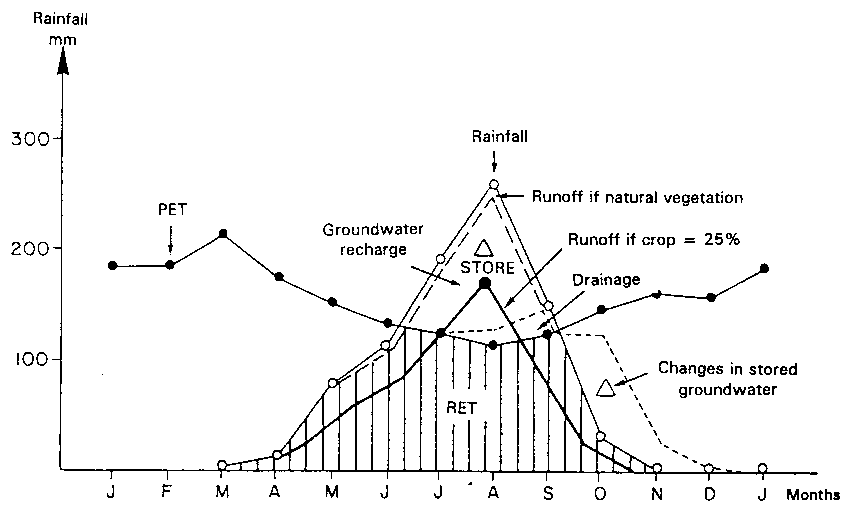
TABLE 4
Chart of the average
water balance for the Ouagadougou region, Sudano-Sahelian
savannah (cf. Roose 1980a)
Month |
Rainfall (mm) |
Potential evapotranspiration
(mm) |
Runoff (mm) |
Actual
evapotranspiration (mm) |
Drainage (mm) |
||
(1) |
(2) |
(1) |
(2) |
||||
January |
0 |
187 |
0 |
0 |
0 |
0 |
0 |
February |
0 |
188 |
0 |
0 |
0 |
0 |
0 |
March |
1 |
216 |
0 |
1 |
1 |
0 |
0 |
April |
19 |
178 |
0 |
19 |
19 |
0 |
0 |
May |
81 |
155 |
2 |
79 |
79 |
0 |
0 |
June |
116 |
136 |
3 |
113 |
113 |
0 |
0 |
July |
191 |
129 |
5 |
129 |
129 |
57 |
0 |
August |
264 |
116 |
7 |
116 |
116 |
141 |
4 |
September |
151 |
126 |
4 |
126 |
126 |
21 |
21 |
October |
37 |
149 |
0 |
37 |
149 |
0 |
0 |
November |
0 |
165 |
0 |
0 |
82 |
0 |
0 |
December |
0 |
160 |
0 |
0 |
0 |
0 |
0 |
Total |
860 |
1905 |
21 |
620 |
814 |
219 |
25 |
% |
100 |
222 |
2,5 |
72 |
94,6 |
25,5 |
2,9 |
(1): gross
(2): corrected
In conclusion, runoff control has different consequences depending on the water balance (Table 4). In high-rainfall areas, runoff reduction leads to a slight improvement in the actual evapotranspiration, but mainly to increased drainage and hence increased risk of leaching and in the rate of flow when the river is at its lowest. Agroforestry can be brought into play to increase the actual evapotranspiration.
In semi-arid zones (with less than 700 mm of mean annual rainfall) runoff reduction increases the stored water available for the actual evapotranspiration, and hence biomass production (and yields).
LONG-TERM EROSION-INDUCED REDUCTION IN SOIL PRODUCTION POTENTIAL
Runoff and erosion can have an immediate deleterious effect on yields of standing crops, but can also progressively modify the physical, chemical and biological nature of the soil (through selective erosion of the most fertile components) and reduce the long-term potential of certain soils, especially thin soils (with poor water- and fertilizer-storage capacities) and forest soils (where fertility and biological activity are concentrated in the surface horizons). It may be wondered whether the productivity of these soils can be restored simply by stepping up the amount of fertilizer used (cost of soil restoration).
In Nigeria, Lal (1983) examined the impact of erosion on the productivity of an alfisol at the IITA station near Ibadan, using three approaches:
• On 24 erosion plots (125 m²) with 1, 5, 10 and 15% slopes, subject to different treatments from 1971 to 1976, he measured different levels of cumulative erosion and calculated the depressive effect of erosion on the characteristics of the surface horizon, particularly for carbon, nitrogen, assimilable phosphorus, pH and total porosity. Multiple regressive analysis of the effect of three soil properties on maize yields indicates that erosion-induced changes in the soil have a significant effect on yields.
Maize yield = 1.79 - 0.007 E + 0.7 (Co) + 0.07 (Po) + 0.002 (Ic) - r = 0.9
Maize yields (in t/ha) fall with cumulative erosion (E in t/ha), but increase with the level of organic carbon (Co in %), total porosity (Po in %) and infiltration capacity (Ic in cm/h). r is the regression factor.
This regression seems to indicate that erosion-induced reduction in soil productivity can be countered primarily by adding organic matter, and secondly through cropping techniques that improve porosity (or water-storage capacity) and infiltration capacity.
• Having obtained varying erosion levels on the same plots, Lal then monitored maize yields during four cropping seasons (1977-78), using the same treatment and average fertilizer rates (40 + 80 N + 26 P, + 30 K per ha).
As foreseen, the least erosion was on the plots with a 1% slope. Despite this low rate, however, the best yields were not from these 1% slopes but on plots with 5, 10 and 15% slopes.
FIGURE 9 Changes in the water balance under natural vegetation as a function of climate (cf. Roose, Lelong and Colombani 1983)

NOTES ON FIGURE 9: EFFECTS OF RUNOFF CONTROL AS A FUNCTION OF THE WATER BALANCE IN SEMI-ARID ZONES
IN HUMID ZONES
IN CONCLUSION: Farmers will be appreciative of improved infiltration in their fields as it allows improved biomass production in semi-arid zones. It
must go hand-in-hand with intensified cropping and sound
nutrient management, especially in humid zones (Rainfall
> 1000 mm). |
FIGURE 10 Maize yields for varying depths of scouring and three levels of N application (IITA Ibadan Station) (cf. Lal 1983)
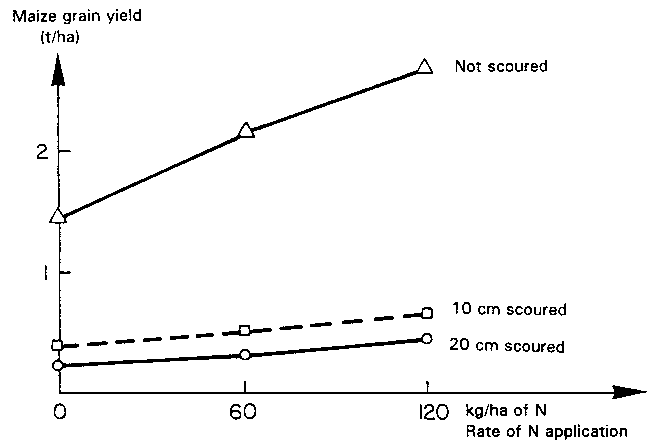
On average, maize yields fell by 0.26, 0.1, 0.08 and 0.1 t/ha per millimetre of eroded soil on plots with 1, 5, 10 and 15% slopes, respectively. The yield reduction rate for a 1% slope is thus two to three times higher than on steeper slopes that are more seriously eroded. This can be attributed to the fact that runoff increases sharply on these flatter plots where infiltration declines faster due to rain splash.
Apparently, above a threshold of 4 mm (60 t/ha) of cumulative erosion in six years, maize yields fall fast. This would give a tolerance rate of roughly 10 t/ha/yr of erosion for this type of soil, although it is difficult to generalize, since productivity reduction rates, as a function of the decrease in soil depth, could have been greater if there had been greater water stress during these four farm seasons.
• Lal tried to speed up his experiments by mechanically scouring the surface of plots with a 1% slope just beside the erosion plots on a ferralitic soil over a gravel sheet at about 25 cm (paleustalf) that had been under bush fallow for 15 years.
The soil was scoured to 0, 10 and 20 cm, and treated at three fertilizer rates (N = 0, 60 and 120 kg/ha; and P = 0, 25 and 75 kg/ha) using a split plot layout, with each treatment repeated three times, and the maize grown without tillage.
Variance analysis shows that scouring has a significant depressive effect on plant height, leaf nutrient content, and the grain and biomass yields. The surprising finding is that the effect of nitrogen application is observable only on plots that have not been scoured, implying that accelerated erosion can irreversibly reduce the soil productivity of shallow soils (negative interaction of erosion with mineral fertilization).
TABLE 5
Three fertilization
levels on degraded soils
Fertilization |
N |
P |
K |
Mg |
Zn |
Mo |
Lime (kg/ha) |
F0 |
0 |
0 |
0 |
0 |
0 |
0 |
0 |
F1 |
110 |
50 |
0 |
20 |
5 |
1 |
0 |
F2 |
220 |
450 |
250 |
100 |
10 |
2 |
3500 |
Moreover, the reduction rate in terms of grain (0.13 and 0.09 l/ha/cm of scoured soil) and straw (0.16 and 0.12 t/ha/cm) is much higher for the first centimetres of topsoil scoured, and would be even more marked if less than 10 cm had been scoured at a time.
Nitrogen and phosphate applications had positive effects on N and P content in the leaves of cultivated plants. If grain yields did not rise in economic terms, this was because of other limiting factors, particularly the porosity, structure and water-storage capacity of deep horizons now exposed to rain splash.
Comparison of productivity losses from artificial scouring (0.013 t/ha/mm) and natural erosion (0.26 t/ha/mm) on the same shallow soil shows that the effects of natural sheet erosion are 20 times more serious than simple mechanical scouring, since sheet erosion selectively removes the most fertile elements: organic matter, clays and loams, and the most soluble nutrients.
Lal concludes that the studies on "scoured plots" gave only relative indications of the impact of erosion on soil productivity, especially on shallow soils (Figure 10).
Another example has been given on a recently cleared oxisol (tropeptic eutrustox, kaolinitic clayey) on the island of Oahu (Hawaii) (El-Swaify, Dangler and Armstrong 1982). Preliminary studies showed that this soil had a strong concentration of fertility in the first ten centimetres as well as in a compact layer at about 35 cm. It was then decided to assess the harmful impact of scouring the first ten centimetres and exposing the subsoil with its unfavourable physical characteristics. The three treatments (scouring of 0, 10 and 35 cm) were restored with three levels of fertilization (0, 50 and 100% of requirements to attain peak production) (Figure 11).
The results showed that this oxisol has a much higher potential (11 t/ha) than the Ibadan alfisol and that fertilization (especially N and P) has a decided influence in almost all situations. Even so, yields fall very sharply when 35 cm of soil is removed, probably because the rooting system develops poorly in this extreme case.
Without fertilizer (Fo), yields fell by half for a 10 cm scouring, and by 90% when the whole humiferous horizon was removed. There appears to be a threshold beyond which yields fall sharply even if large doses of fertilizer are applied (110 N + 50 P) (Table 5).
The cost of restoring severely scoured soil becomes uneconomic (220 N + 450 P + 250 K + 3500 CaO), for the physical properties of the subsoil are unsuitable for root growth and the soil's phosphorus fixation rate is very high. The economic impact of erosion is particularly marked when restoration of the subsoil requires major phosphate and lime inputs, a syndrome very frequent in tropical soils.
FIGURE 11 Maize production as a function of the level of mechanical scouring and mineral fertilization with a view to restoring productivity (2nd harvest) (cf. El-Swaify, Dangler and Armstrong 1982)
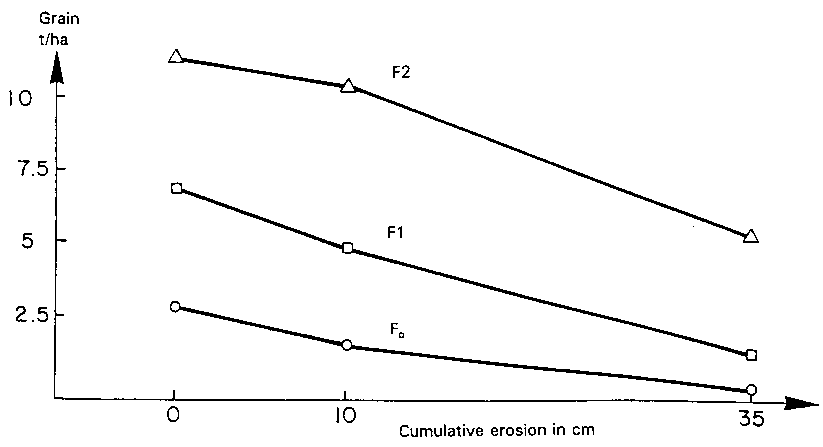
These two experiments on tropical soils with very different productivity demonstrate clearly how sheet erosion, although hard to see, can have a serious long-term effect on the productive capacity of soils. Even if it is modest in annual terms, this depressive effect is cumulative, eventually thrusting itself into the limelight when certain properties of the soil pass tolerance thresholds:
• levels of organic matter (0.6% according to Pieri 1989) and clay (10%),
• structural stability and infiltration capacity,
• water- and nutrient-storage capacity.
A soil degraded through sheet erosion is a tired soil and barely reacts to applications of mineral fertilizer. This is what happens with shallow ferralitic soils on ironstone or gravel sheet, and soils with compacted horizons close to the surface.
Even so, not all soils are non-renewable natural resources. In the section on "Restoring Soils and Rehabilitating Land" in Chapter 2, it was seen that if a series of six rules is respected (and not simply the application of mineral fertilizers), the fertility of a good number of sufficiently deep soils can quickly be restored. However, the cost of such restoration rises the longer the delay in protecting the soil: thus the soil has to be tilled in depth, fermented organic matter, fertilizers and conditioners have to be applied, the induced porosity has to be taken over by an abundant biomass... and the soil has to be protected against runoff.
Lastly, in the very special case of old ferralitic soils that are acid and completely desaturated (ultisols), it might seem best to speed up their erosion in order to improve their productivity. However, the price would be high, for one must take account of the impact of huge quantities of sterile matter that would clutter up the richer plains, and also envisage a major investment in order to restore fertility to the rejuvenated soils. When experimental bench terraces were built on the Rwanda hills, nothing grew on these soils altered down to Horizon B without a huge application of manure (30 t/ha) combined with liming (3 t/ha every two years) and supplementary mineral dressings (50 N + 50 P + 50 K) (Rutunga 1992).
So erosion affects the production potential of a soil. In the case of a desaturated ferralitic soil (e.g., alfisols), if it has been eroded it can no longer store water and nutrients and supply them to crops as and when needed. It has also lost some of the biogenic components of the topsoil, and so micro-organisms are inefficient or slower at recycling the nutrients contained in the soil. Lastly, rooting is usually insufficient in the subsoil when the topsoil has been eroded.